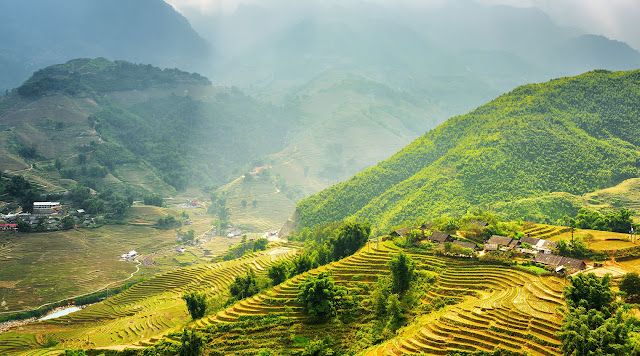Although Northern Vietnam gets fewer visitors than other popular destinations like Ha Noi or Ho Chi Minh city, this is a region of the country that you should visit once when traveling to Vietnam. It is home of many breathtaking bays, stunning rice terraces and unlimited scenery.
Mai Chau
Mai Chau is a wonderful place to explore if you’re looking to get an authentic view of the many cultures that have found a home in Northern Vietnam. In the heart of the Hoa Binh Province, Mai Chau is a district with lush greenery, beautiful mountains and vibrant culture. In addition to the verdant valleys, Mai Chau is noteworthy for its stilt houses. These houses are constructed 3 meters off the ground, and they often provide shelter to animals escaping inclement weather.
Ha Long Bay
The UNESCO World Heritage Site of Ha Long Bay is the most visited destination in all of Vietnam. Hundreds of tiny islands - many of them inhabited only by monkeys - feature dozens of caves and innumerable deserted beaches. Magnificent limestone towers rise above the waters of the bay like brooding primeval sentinels. Ha Long Bay stretches out along the Tonkin Gulf, just a three-and-a-half-hour drive north of Ha Noi. For an unforgettable experience,
Cat Ba Island
Known as the largest mainland island of Ha Long Bay, Cat Ba Island is a great option for sightseeing. The central hub of Cat Ba Town is now framed by a chain of low-rise concrete hotels along its once-lovely bay, but the rest of the island is largely untouched and as wild as ever.
Sapa
The mountainous town of Sapa is known for its culturally diverse population as well as its proximity to incredible scenery. Sapa itself is home to the members of many hill tribes, including the Hmong, the Dao, the Muong and the Tay. The town also overlooks the magnificent Muong Hoa Valley and its terraced rice fields, which are staggering to behold. If you want to get an inside look at the local residents and their cultures, then head to Sapa for an overnight trek or a homestay. You can hike out to the more remote villages and then spend the night, dining and learning from the hill tribe residents.
Ninh Binh
Several tranquil rivers meander near the city of Ninh Binh, just 58 miles south of Ha Noi. Take a ride on an aluminum rowboat paddled by local village women and marvel at the rugged karst terrain, mountain goats, and lush foliage as you glide along peaceful river waterways through a series of dark grottoes. In addition, you can easily visit Ninh Binh as a day trip from Hanoi, though if you want to stay longer, check out Cuc Phuong National Park, Vietnam’s oldest national park.
Dong Van Plateau
Dong Van Plateau starts just north of the city of Ha Giang, about a six-hour drive from Ha Noi. It is a spectacular part of the remote, mountainous region of Vietnam’s far northeast. Spectacularly terraced rice paddies climb to the summits of the surrounding mountains, extending beyond the horizon. Further exploration uncovers more gems: Southeast Asia’s deepest canyon, 22 ethnic minority tribes, pristine lakes, pine forests, stone forests, caves bristling with undisturbed formations, and incredible waterfalls are just a few of the many treats that await the intrepid explorer.
Source Internet












